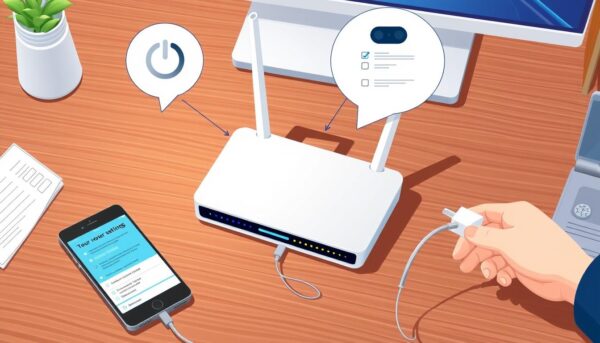✅ Last checked on
Ever wondered why your internet drops at the worst times? Many think it’s just part of life. But resetting your router might be the answer. Here, you’ll find key tips to boost your router’s performance and internet connection.
Key Takeaways
- Rebooting your router can fix most common performance issues.
- Regularly restarting your router is crucial for optimal security and performance.
- Resetting may be necessary if issues persist even after multiple restarts.
- A hard reboot can solve about 90% of internet problems.
- Experts suggest replacing your router every 2-5 years based on usage.
Understanding the Importance of Router Performance
Your router is key to keeping your Internet connection stable. It acts like a traffic controller for your data. Its performance affects your connection speed and how well devices connect.
Why Your Router is Crucial for Internet Connectivity
Router performance affects your browsing, streaming, and downloads. A good router makes sure data moves fast and smoothly. You should look at:
- Latency: The time it takes for data to travel across the network.
- Packet Loss: Instances where data packets fail to reach their destination.
- Device Usage: The number of devices connected to the network can strain bandwidth, affecting overall performance.
- Network Congestion: High traffic can slow down connectivity.
Keep an eye on these factors for the best router performance. You can find more info on common network performance myths that might affect you.
Signs You Need to Reset Your Router
Some signs show you might need to reset your router. Look out for:
- Slow internet speeds that disrupt your activities.
- Frequent disconnections that frustrate your online experiences.
- Difficulty in connecting new devices to your network.
Restarting your router regularly helps. Do it every few weeks or monthly. For older routers, weekly restarts can keep performance up. Power cycling by unplugging the router for 15 seconds can fix small issues and boost Wi-Fi speed.

Reset Router Tips
Knowing the difference between rebooting and resetting your router is key to keeping it running well. Rebooting refreshes the device’s memory, while resetting takes it back to its factory settings. This means you’ll need to set it up again, including entering your ISP login details, to get back online.
The Difference Between Rebooting and Resetting
Rebooting your router every few months is a good idea to keep it running smoothly. It’s a simple step that can fix many short-term problems. To reboot, just unplug the router for thirty seconds and then plug it back in.
Resetting is for more serious issues that rebooting can’t fix. For most routers, hold the reset button for ten seconds to start the reset.
Common Issues That Require a Router Reset
There are a few times when you might need to reset your router:
- Problems that keep coming back even after rebooting.
- Forgotten passwords that block access to your router settings.
- Slow Wi-Fi speeds compared to wired connections.
- Blinking lights on your router, which can mean misconfigured settings or ISP issues.
If resetting doesn’t solve the problem, check your connections, settings, and firmware. If you’re still having trouble, you might need a new router or a faster internet plan. A hard reboot can fix over 90% of router problems, making it a good first step before a factory reset.
How to Perform a Hard Reboot
When your router has connectivity issues, a Hard Reboot can help a lot. It’s a simple process that fixes many problems. First, check if your router has a battery backup. This ensures a smooth reboot.
Step-by-Step Guide for a Hard Reboot
- Unplug the router from the power source.
- Wait at least 30 seconds to allow any residual power to dissipate.
- If equipped, unplug the modem as well and wait 60 seconds before plugging it back in.
- Reconnect the power to your router and wait for at least 2 minutes for it to stabilize.
- Once the power light of the router is consistently glowing, connect your devices and check if the problems persist.
This method clears the router’s memory, starting fresh. If problems still exist, look for other causes.
Checking for Power Issues and Battery Backup
Before starting the hard reboot, check for power issues. Some routers stay on with a battery backup. This can block the reset. Make sure to:
- Inspect the power adapter and check for any damage.
- Confirm that the power outlet works by plugging in another device.
- Ensure all connections are secure and intact.

Knowing these steps is key for a successful reset. For more tips on keeping your network running well, check out this guide.
Resetting Your Router to Factory Settings
Knowing when to reset your router can really help your internet. You might need to reset it if you forget your password or have ongoing network issues. This action will remove all custom settings, so you’ll need to set them up again.
When to Consider a Factory Reset
Here are some common reasons to reset your router:
- You forgot the admin password.
- The router rejects your admin password.
- You reboot it multiple times a day.
- Experiencing unusually slow speeds, even on wired connections.
- Your router acts strange following a firmware update.
Steps for Resetting Different Router Models
Resetting different routers requires specific steps. Here’s how to reset some common brands:
| Router Model | Quick Reset Instructions | Web Browser/Mobile App Reset |
|---|---|---|
| ASUS | Press and hold the Reset button for 5–10 seconds until power LED flashes. | Select Advanced Settings -> Administration -> Restore/Save/Upload Setting -> click Restore. |
| Eero | Soft reset: Hold for 7 seconds; Hard reset: Hold for 15 seconds. | Use the mobile app to access reset options. |
| Linksys | Press and hold the Reset button for 10 seconds until the power LED flashes. | Access through the web interface to reset. |
After resetting, your network settings will be gone. If you have trouble, try the 30-30-30 reset method. Press the reset button for 30 seconds, then unplug for 30 seconds, and plug back in with the reset button pressed for 30 seconds. Remember, resetting to factory settings means you’ll have to set up your custom settings again.
Conclusion
Resetting your router regularly is key to keeping your internet stable and fast. By following the tips in this article, you can make your network work better. Problems like slow internet or Wi-Fi issues can often be fixed with a simple reset.
For small network problems, a soft reset works well. But for bigger issues, you might need a hard reset. Being ready, like backing up settings and knowing default login info, helps a lot.
Knowing when and how to reset your router helps you solve internet problems. By making it a regular part of your digital care, you help keep your network strong and efficient.